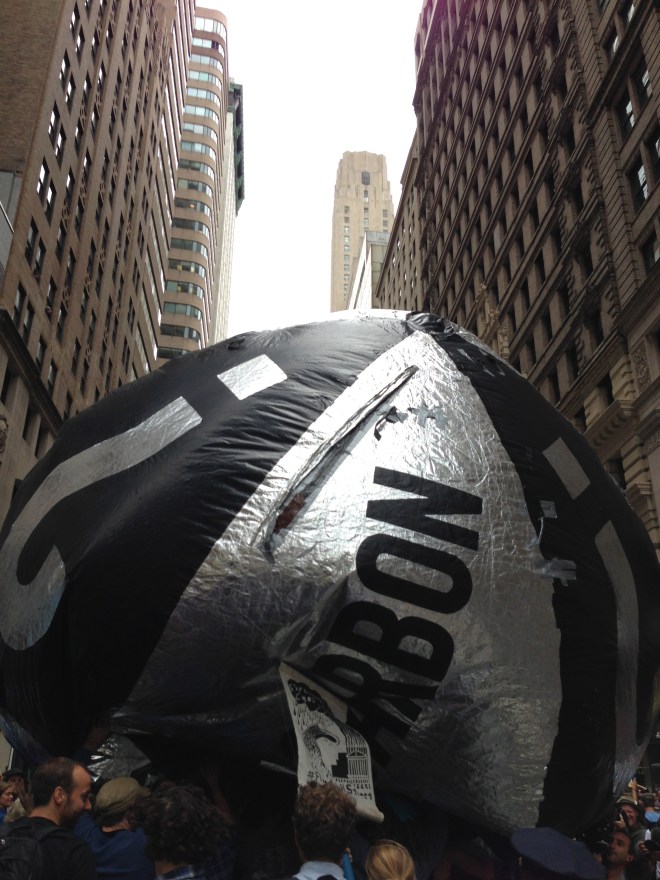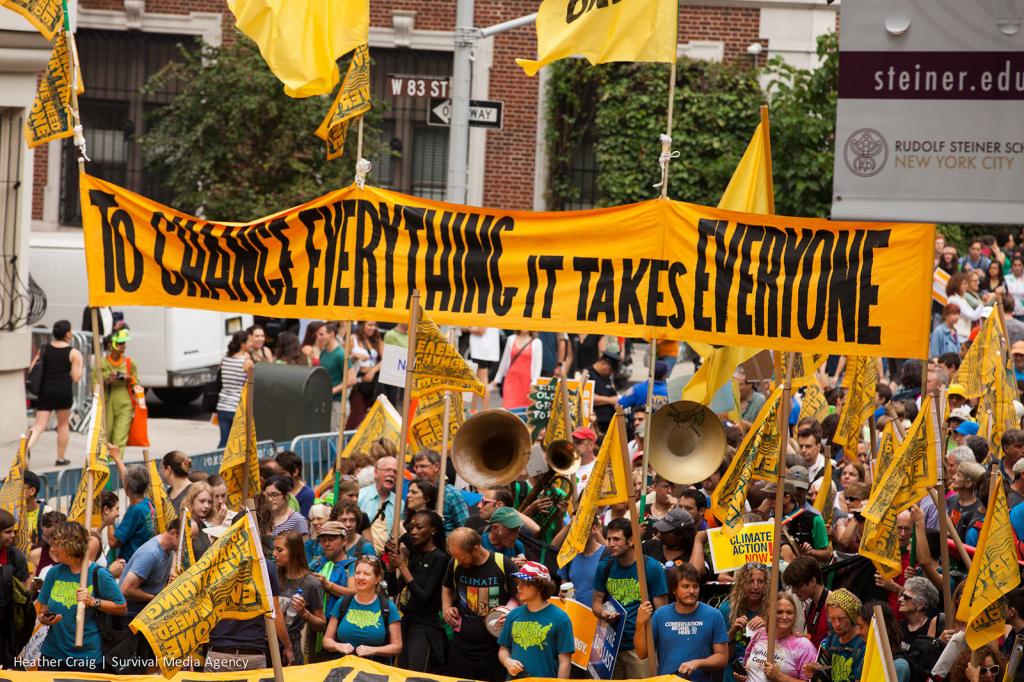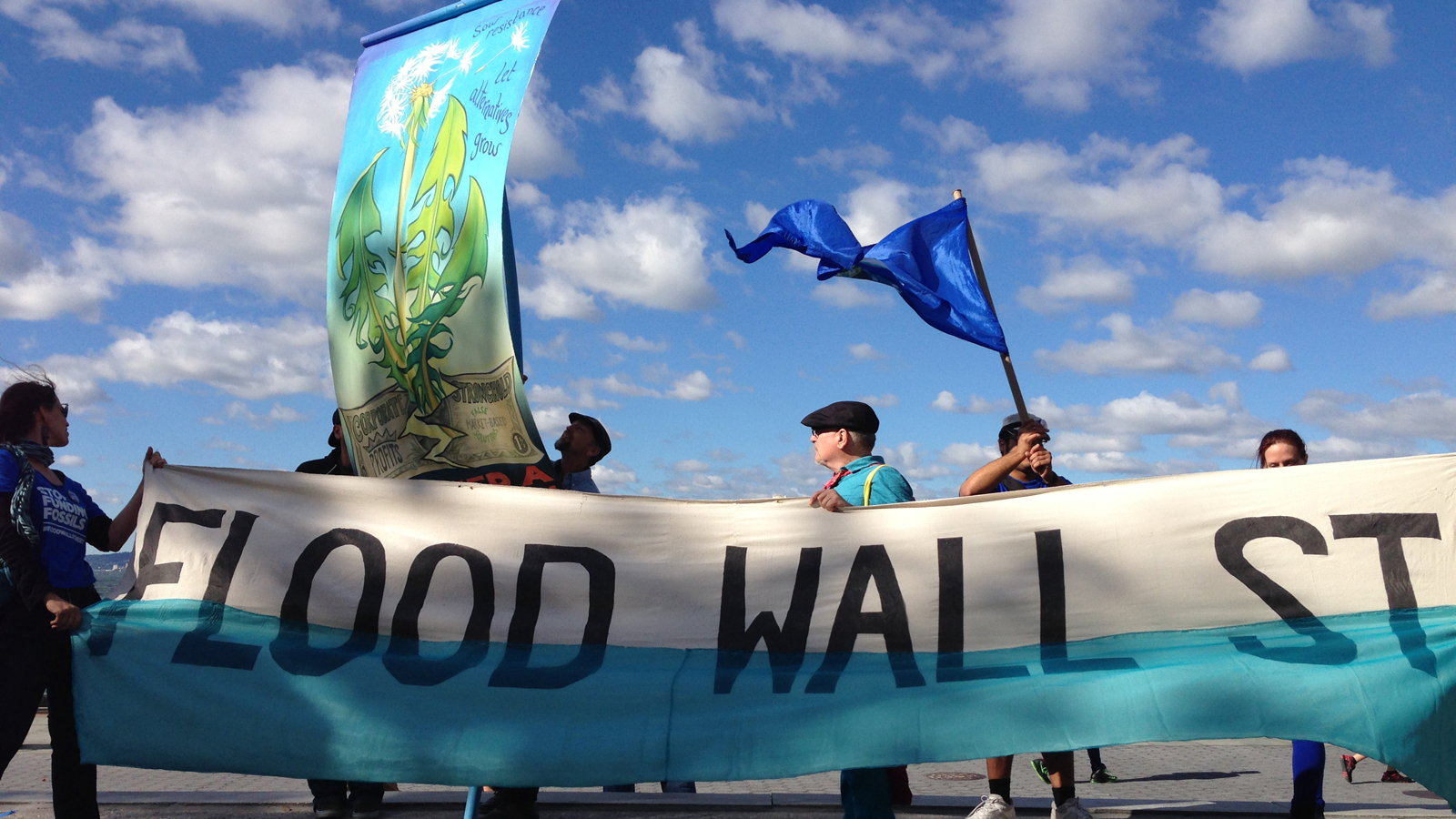It is a beautiful day to get arrested: not too hot, not too cold, and a crisp breeze coming off of the waterfront. I am hanging out in Battery Park at the southernmost end of Manhattan Monday morning with several thousand protesters dressed all in blue, several hundred policemen, a few confused tourists, and Captain Planet.
“Are you the same Captain Planet that protested Keystone in D.C.?” I ask.
“I am,” she says. “There is another Captain Planet, but that one went to get breakfast.”
Sure enough, a second Captain Planet comes into view, carrying two enormous hot pretzels. In regular life, Captain Planet II works in Louisiana, helping people measure the pollution in their communities. For the purposes of this direct action, though, she’s wearing a spare costume purchased off the internet by the first Captain Planet, but rejected for aesthetic reasons.
“She didn’t like the granny panties,” says Captain Planet II.
“Yeah. Though all that means is that I’ve got a wedgie instead,” says Captain Planet I.

On Sunday, 310,000 people marched down Central Park West, along 42nd Street, and down to Javits Center in what was the largest climate-related environmental protest in history. The protest planned for Monday, the day before the U.N. Climate Summit, is meant to be endearing and serious, but also confrontational in a way that Sunday’s wasn’t.
Specifically, the goal is to march onto Wall Street, pretending to be the rising waters of climate change, and to lie down on the pavement, shutting down traffic and calling attention to how financial markets contribute to climate change by overvaluing oil, gas, and coal companies — a trifecta that’s known as the “carbon bubble.”
The only problem is, getting arrested — especially civil-disobedience-style arrested — can take a long time. And the Captain Planets, like a lot of the people here, are out-of-towners with a plane to catch.
“Getting arrested in XL Dissent was like a perfectly orchestrated symphony that we did together with the police,” Captain Planet I says. “This feels more chaotic and real. I want to get arrested! But we’ve talked about it and it’s not a good idea!” Captain Planet II looks deep into the eyes of Captain Planet I. “If we miss our plane,” she says, calmly, “we miss our plane.” Captain Planet grins back at her.
In fact, Flood Wall Street is coordinating with the police, in the sense that the organizers have negotiators working with the department. “We have a lot of people in from out of town,” explains Michael Premo, a theater director and artist who is helping to coordinate Flood Wall Street. “We’ve just done this one other time, when we had a protest over Sandy relief funds in New Jersey.”
“This is good,” says Priscilla Grim, surveying the crowd. “This is a lot more than I thought we’d get.” Grim’s specialty at Flood Wall Street is social media. (“First rule of social media,” she says: “Guys will always try to steal the password and use it to post stupid shit on the internet. I’ve seen this happen since the ’90s.”) She is not planning on getting arrested, though her husband is. “I’m so proud of him,” she says. “We take turns.”
Most of the people in the crowd are dressed up — either in blue, or in strange costumes of their own devising. Grim and a friend who handles Flood Wall Street’s Facebook account are dressed in business casual, and thereby indistinguishable from all the non-protesters reading morning papers and sipping morning coffee in the park. This is protective coloration, in case the protest gets out of hand and police start arresting people willy-nilly. “I’m just a temp!” squeaks Grim’s friend, cheerfully, to an imaginary police officer. “I’m just here on my lunch break!” squeaks back Grim.
A guy wearing dusty, head-to-toe black stops by and cuts into our conversation. “So!” he says. “The police! They’re onto us! They know we’re going to march down Broadway! So here’s what we’re going to do! A dam can stop a river, but it can’t stop a drop of water. We’re going to trickle around the barricades! Spread the word!”
“Hey,” says Grim. “Isn’t there a planning meeting going on?” “Yeah,” says the guy. “Well there you go,” says Grim, angling her chin towards the group of several thousand people gathered around the World War II Memorial. “Bring it up there.” The guy wanders off.
“Have you ever seen that guy before?” Grim asks. “I think once?” says her friend. They both shrug. Anyone with a passing knowledge of the internet could not have failed to notice that a big protest was being planned on Wall Street Monday, and, sure enough, Broadway is lined with barricades and police.
As I walk down the street, I overhear one of the police officers regaling a group of passersby about the 14-hour shift that she worked Sunday, policing the climate march. “It was the biggest protest I’ve seen!” she said. “It took five hours just for everyone in the parade to start! If they’d wanted to, they could have taken over the whole city. We had no idea there were going to be so many! We were completely outnumbered!”
“So what’s today’s protest?” one of the women asks. “This is Occupy,” says the police officer. “They’re going to be different. They’re fine, but they’ve got their point and they’re going to make it.”
I walk back towards the park and notice that the police are on the move. So are a surprising number of people in blue who are briskly walking out of the park, trying to look nonchalant. A small group of people runs past me, gazelle-like: photographers.
I follow them, and find myself underneath one of the carbon bubbles — two giant balloons the protesters are lofting. The thing is huge, and as the crowd flows through the tour buses and taxis that are trying to move down Broadway, it bounces around like a giant beach ball. A motorcyclist stops, takes off his helmet, and high-fives people in the crowd as they move past him. The tourists lean over the edge of the bus and cheer.

It’s hard to tell what happens next. Does the crowd lose control of the carbon bubble, or do the police somehow grab it? Once it’s on their side of the barricades, they stomp it down and drag it away from the crowd.
Meanwhile, the other carbon bubble is half-deflated, and protesters whip out a roll of gaffer tape and a portable air pump and begin trying to re-inflate it. They repair the bubble after about a half-hour of labor and roll it back and forth down Broadway until the police manage to confiscate that one, too. I look down to the end of the street.
At that, the crowd settles into chanting. Those waiting to be arrested sit down in the middle of the street and get comfortable. Sharpie markers are circulated among them so that people can writer relevant phone numbers on their arms. Representatives from the National Lawyers Guild pass around a notebook so that those planning to be arrested can write down their information in it.
“If your name is in this book and you do not get arrested,” one of the lawyers says, “I need you to call the guild and say, ‘I have not been arrested,’ so that we aren’t at the jail looking for you.”
Two women pull out signs and begin cornering any reporter they can find and lecturing them about the lives of children in Afghanistan, which can be made better by donating to their organization.
“Is this about the environment?” one of the reporters says. “This is about the very difficult environment that the children of Afghanistan are living in, so yes,” the woman replies.
Hours drag on, and still no arrests. Attitudes in the crowd range from delight (at not having any violent confrontations with police) to alarm (if there are no confrontations with police, will the media still care?). Protesters begin to pull apart the barricades. One of them makes a neat pile of them and stands on top of it, giving interviews. “This never would have happened before,” one of the protesters says to me. “During Occupy, if we blocked Broadway, we would have been arrested within minutes.” People comment on a few signs of negotiations in progress with police — the tour buses that were trapped in the surge of protesters have been allowed to leave, which they do, driving off with much waving and cheering.
Speculation begins. Is the DeBlasio administration going to try to wait the protesters out? Forget confrontations — will the editors of all these reporters here still run their stories if no one gets arrested at all? Since the whole point was to disrupt Wall Street during business hours, should both sides just declare victory and leave when the exchanges close at 4 p.m.?
People start to get hungry, and Flood Wall Street orders a stack of pizzas for the crowd waiting to get arrested. There is some napping in evidence. At 4 p.m., the crowd starts moving again, racing up Broadway toward Wall Street itself. A few people get pepper-sprayed when they move a barricade, and one guy gets arrested, but still the police make no move to arrest the crowd itself.
By the time the arrests finally commence, at 6:45 p.m., the sun is beginning to set. The police give an order to disperse.
The crowd in the street awaiting arrest has been there for nearly seven hours and has shrunk by about half, to roughly a hundred. Outside the barricades, where protesters who don’t intend to get arrested have moved, they’ve been yelling insults at the police for hours. But the message keeps drifting: One group of protesters shouts, “Don’t shoot” and “You killed Eric Garner!” while another group yells, “Way to mix messages!” back at them. “Fuck the police!” gets outshouted by another group yelling “It’s your planet too!” which segues into “We’re here for your children!”
“You look like a sensible man,” says one of the police officers to the photographer standing next to me. “Tell those people standing on the trash bins not to hold that wire for support. That’s an electrical wire.”
The police begin arresting the costumed figures first. They have thoughtfully arranged themselves at the edges of the crowd for the benefit of the photographers. Frostpaw the polar bear gets cuffed, to cries of “Don’t arrest the polar bear!” followed by the two Captain Planets.
“Slumber party in the tombs tonight!” one of the Captain Planets yells.
When I first met the Captain Planets, they just seemed campy and fun. But seeing them handcuffed is strangely affecting. When I was growing up, Captain Planet was easily one of the most boring cartoons on television — it was simplistic, it was sanctimonious, and it completely lacked anything approaching narrative drama or suspense. But the main reason the show lacked suspense was that Captain Planet was invincible. All the Planeteers had to do was put their damn rings together, and Captain Planet would show up and fix everything.
I’ve just spent two solid days watching endless crowds of people arrive in a strange city to work together for the environment. The sheer scale still has an aura of magic around it that hasn’t quite dissipated. Something big started. But this particular moment, at least, is ending. We stand there in the cold and watch the green-mulleted and spandexed heroes of the ’90s disappear into the police bus.



